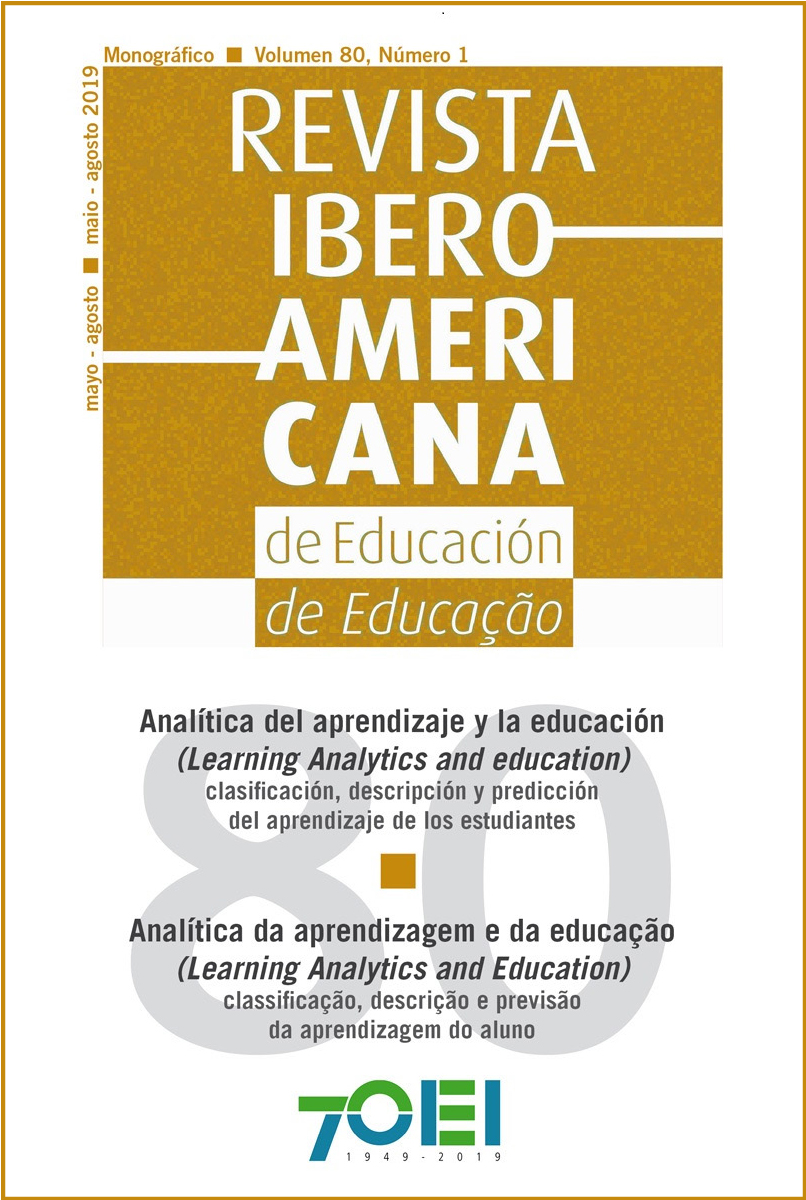Indicadores necesarios para diseñar un dashboard desde la perspectiva de los profesores: un estudio cualitativo
DOI:
https://doi.org/10.35362/rie8013462Palabras clave:
learning analytics;, dashboard;, diseño del curso;, profesor;, proceso de aprendizaje del estudiante;, autorregulación;Resumen
El número de estudiantes matriculados en cursos online de educación superior está aumentando, y como resultado, se generan más datos sobre su proceso de aprendizaje. Los datos generados pueden ser mostrados en un dashboard y ayudar a los estudiantes en su proceso de aprendizaje. Sin embargo, la perspectiva de los profesores debe ser tomada en cuenta a la hora de definir los indicadores del dashboard, ya que el diseño de los cursos podría tener un impacto en los elementos incluidos en el mismo. Y ese es precisamente el objetivo de este trabajo: definir los indicadores necesarios para diseñar un dashboard para los estudiantes en los cursos online teniendo en cuenta la perspectiva de los profesores. Este estudio se realizó con 10 profesores de la Facultad de Humanidades y Educación de Mondragon Unibertsitatea. Se utilizaron cuestionarios online cualitativos para recoger las percepciones de los participantes. Los resultados muestran que la mayoría de los profesores que participaron en el estudio de investigación identificaron cuatro indicadores para diseñar un dashboard para los estudiantes: número de veces que los estudiantes acceden al foro del curso, cantidad de contribuciones en el foro, número de veces que los estudiantes consultan la guía de estudiante del curso, y el número de veces que cada estudiante ha accedido al curso en una semana. Las conclusiones extraídas de este estudio destacan la importancia de formar a profesores y estudiantes en el uso pedagógico de la visualización de datos.
Descargas
Citas
Baker, B. M. (2007). A conceptual framework for making knowledge actionable through capital formation. University of Maryland University College.
Buckingham Shum, S., & Ferguson, R. (2012). Social learning analytics. Educational Technology & Society, 15(3), 3-26.
Corrin, L., & de Barba, P. (2015). How do students interpret feedback delivered via dashboard? Paper presented at the International Conference on Learning Analytics and Knowledge, Poughkeepsie, NY.
Dawson, S., Gasevic, D., Siemens, G., & Joksimovic, S. (2014). Current state and future trends: a citation network analysis of the learning analytics field. Paper presented at the International Conference on Learning Analytics and Knowledge, Indianapolis, IN.
Dawson, S., Bakharia, A., & Heathcote, E. (2010). SNAPP: Realising the affordances of real-time SNA within networked learning environments. Networked Learning-Seventh International Conference.
Dawson, S., Heathcote, E., & Poole, G. (2010). Harnessing ICT potential: The adoption and analysis of ICT systems for enhancing the student learning experience. International Journal of Educational Management, 24(2), 116-128.
Ferguson, R. (2012). The state of learning analytics in 2012: a review and future challenges (KMI-12-01). The Open University, UK.
Few, S. (2007). Dashboard confusion revisited. Perceptual Edge.
Gasevic, D., Dawson, S., & Siemens, G. (2015). Let´s not forget: learning analytics are about learning. TechTrends, 59, 64-75.
Goodyear, P. (2015). Teaching as design. HERDSA Review of Higher Education Vol. 2, (pp. 27-50).
Heathcote, E. (2006). Learning design templates-A pedagogical just-in-time support tool. In G. Minshull & J. Mole (Eds.), Designing for learning: The proceedings of Theme 1 of the JISC Online Conference: Innovating e-Learning (pp. 19-26).
Ipiña, N., Basagoiti, R., Jimenez, O., & Arriaran, I. (2016). Recommendations as a key aspect for online learning personalization: perceptions of teachers and students. International Scholarly and Scientific Research & Innovation 10(10) 3391-3395. doi:10.5281/zenodo.1127511
Krumm, A. E., Waddington, R. J., Teasley, S. D., & Lonn, S. (2014). A learning management system-based early warning system for academic advising in undergraduate engineering. In J. A. Larusson & B. White (Eds.), Learning analytics: from research to practice (pp. 103-119). New York: Springer Science+Business Media.
Leony, D., Pardo, A., de la Fuente Valentín, L., De Castro, D. S., & Kloos, C. D. (2012). GLASS: A learning analytics visualization tool. 2nd International Conference on Learning Analytics and Knowledge.
Lockyer, L., Heathcote, E., & Dawson, S. (2013). Informing pedagogical action: Aligning learning analytics with learning design. American Behavioral Scientist 57 (10) 1439-1459.
Means, B. (2014). Learning Online. What research tells us about whether, when and how. New York: Routledge.
Mor, Y., Ferguson, R., & Wasson, B. (2015). Editorial: Learning design, teacher inquiry into student learning and learning analytics: A Call for action. British Journal of Educational Technology, 46(2), 221-229.
Pardo, A., Jovanovic, J., Dawson, S., Gasevic, D., & Mirriahi, N. (2017). Using learning analytics to scale the provision of personalised feedback. British Journal of Educational Technology. doi: 10.1111/bjet.12592.
Rientes, B., Boroowa, A., Cross, S., Kubiak, C., Mayles, K., & Murphy, S. (2016). Analytics4Action evaluation framework: A review of evidence-based learning analytics interventions at the Open University UK. Journal of Interactive Media in Education, 1(2), 1-11. doi:10.5334/jime.394
Schwendimann, A., Rodriguez-Triana, M. J., Vozniuk, A., Prieto, L. P., Shirvani Boroujeni, M., Holzer, A., Gillet, D., Dillenbourg, P. (2016). Perceiving learning at a glance: A systematic literature review of learning dashboard research. IEEE Transactions on Learning Technologies 10(1), 1-1. doi:10.1109/TLT.2016.2599522
Steiner, C. M., Kickmeier-Rust, M. D., & Albert, D. (2014). Learning analytics and educational data mining: An overview of recent techniques. Learning analytics for and in serious games, pp. 6-15.
Sutherland, R., Eagle, S., & Jobert, M. (2012). A vision and strategy for Technology Enhanced Learning. STELLAR Network of Excellence.
Tanes, Z., Arnold, K. E., King, A. S., & Remnet, M. A. (2011). Using signals for appropiate feedback: perceptions and practices. Computers & Education, 57, 2414-2422. doi:10.1016/j.compedu.2011.05.016
Verbert, K., Govaerts, S., Duval, E., Santos, J.L., Assche, F., Parra, G., et al. (2014). Learning dashboards: an overview and future research opportunities. Personal and Ubiquitous Computing, 18 1499-1514. doi:10.1007/s00779-013-0751-2
Wise, A. F. (2014). Designing pedagogical interventions to support student use of learning analytics. Paper presented at the International Conference on Learning Analytics and Knowledge, New York, NY.
Yoo, Y., Lee, H., Jo, I. H., & Park, Y. (2015). Educational dashboards for smart learning: Review of case studies. Emerging Issues in Smart Learning. Springer, (pp. 145-155).
Cómo citar
Descargas
Publicado
Número
Sección
Licencia
Aquellos autores/as que tengan publicaciones con esta revista, aceptan los términos siguientes:















